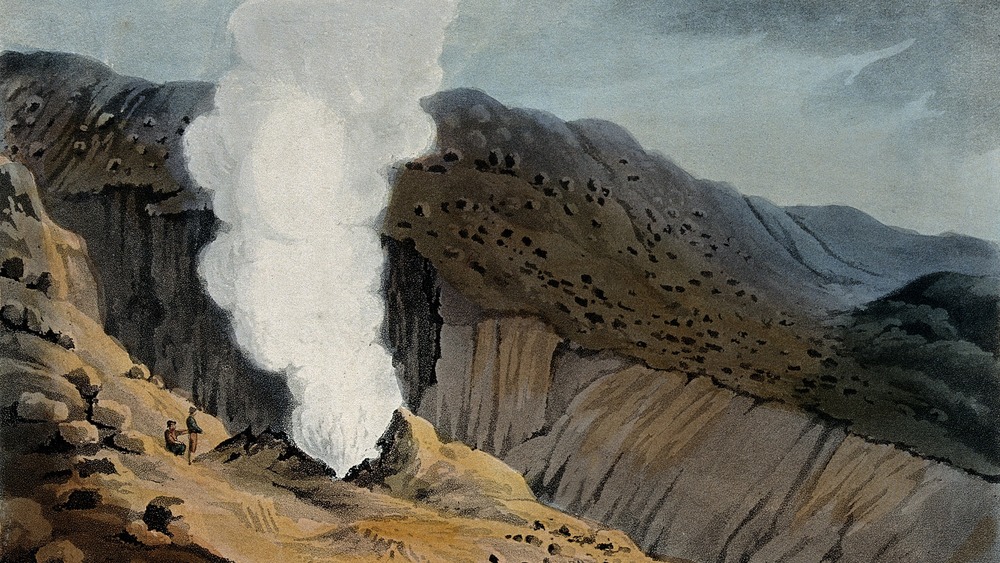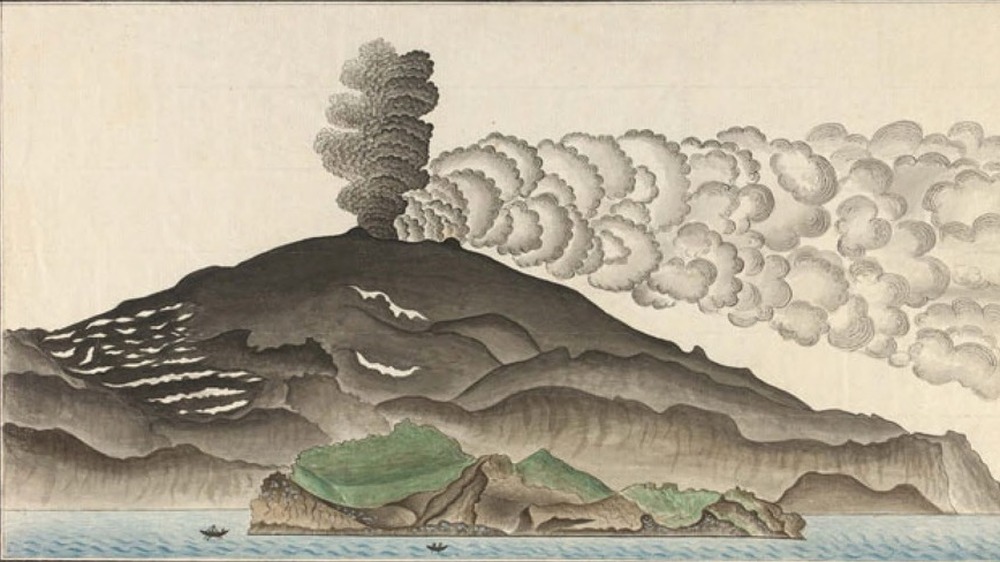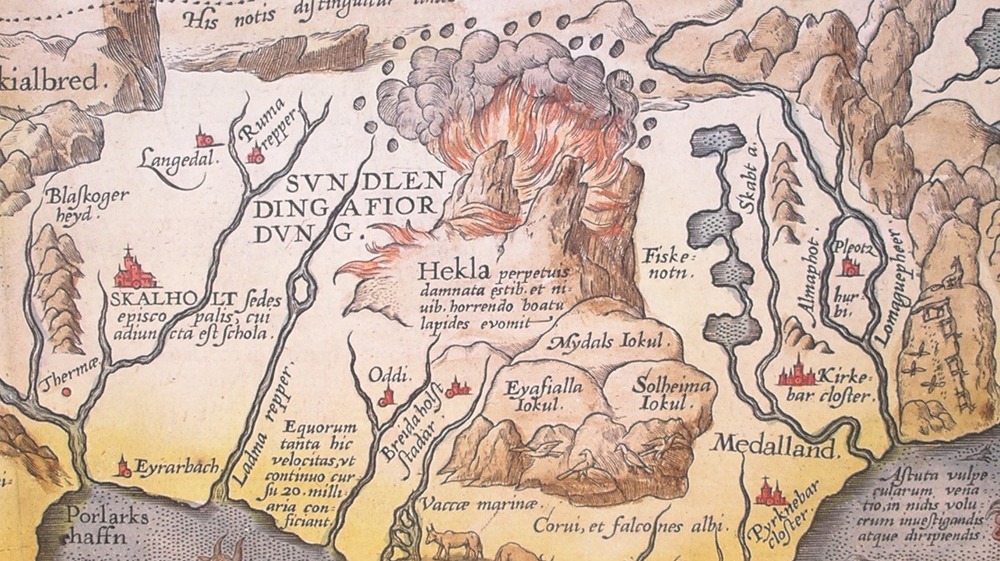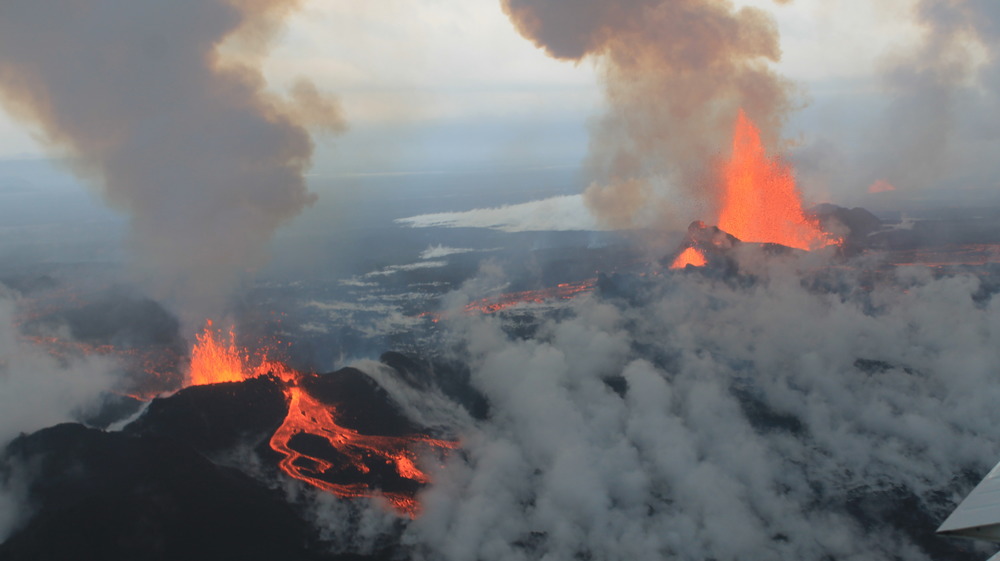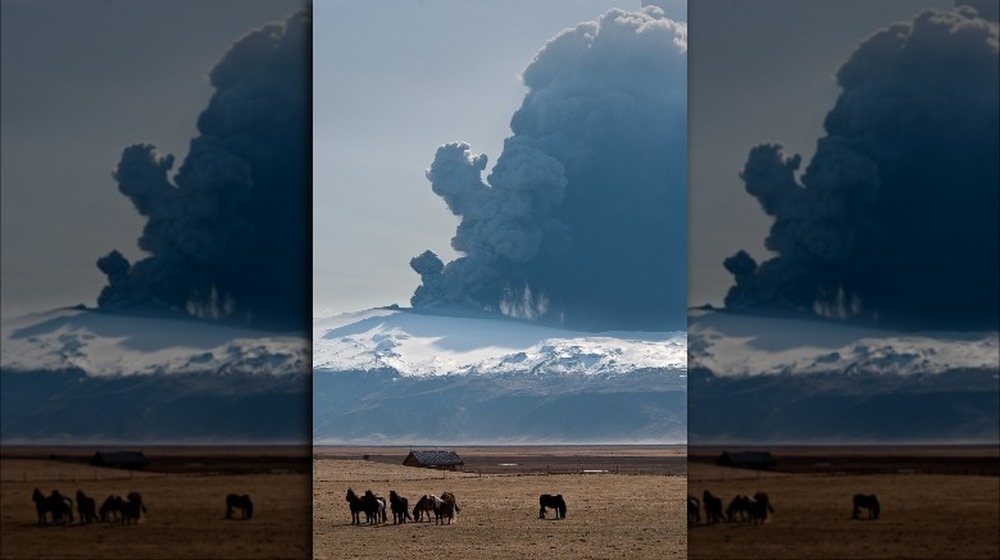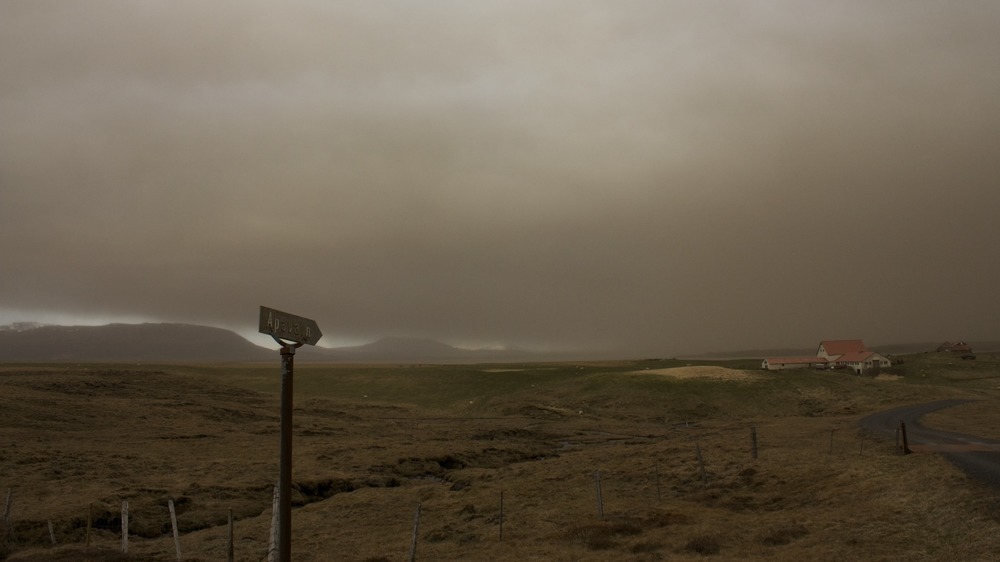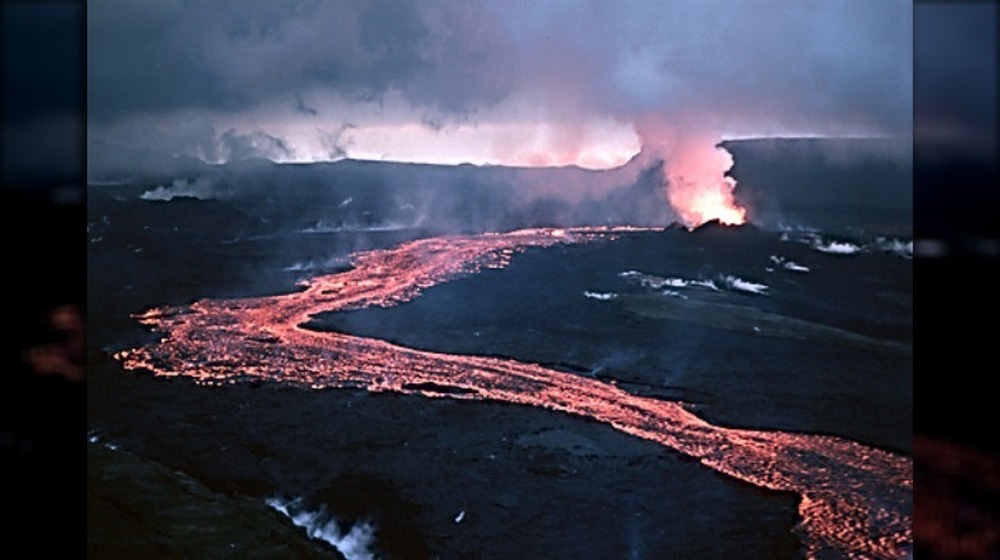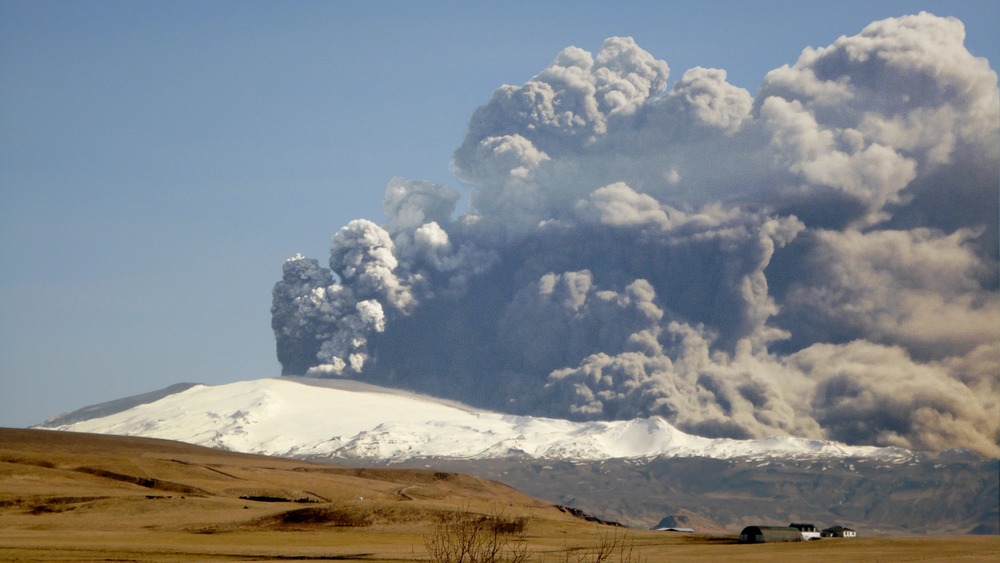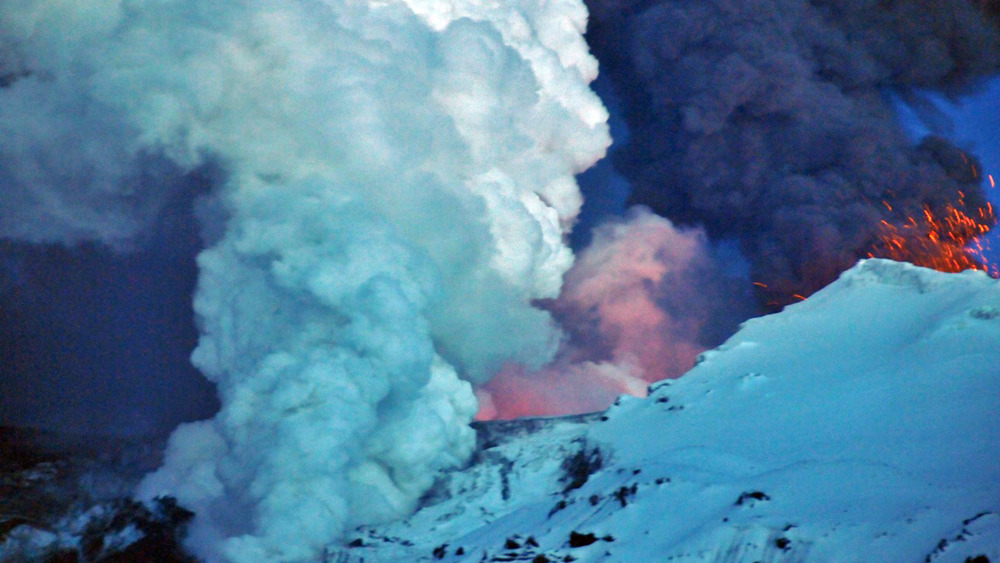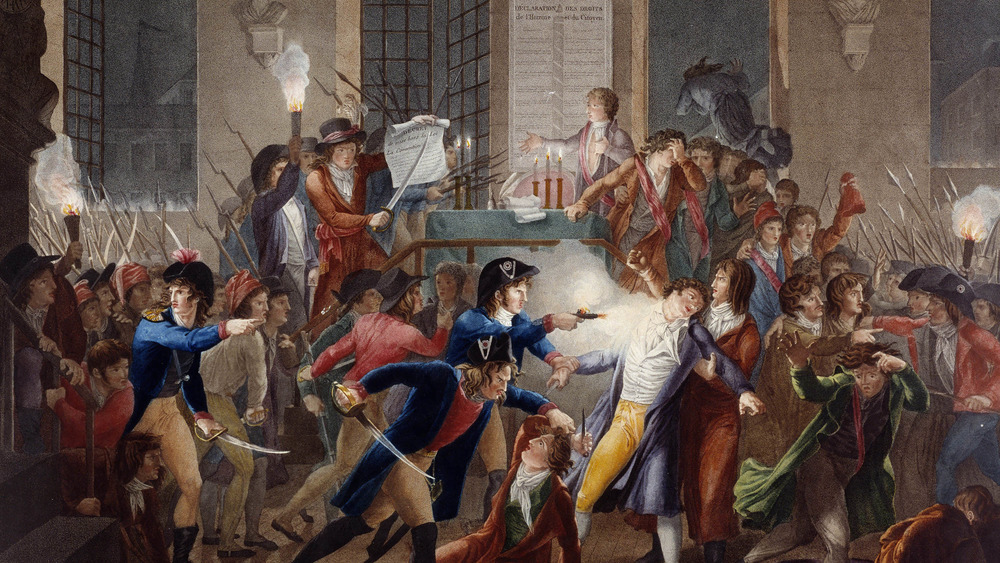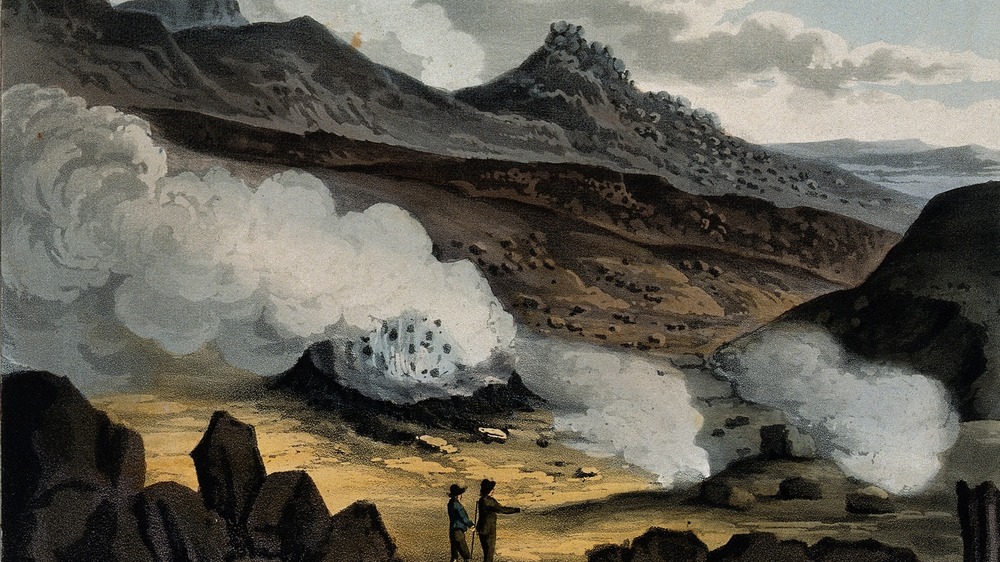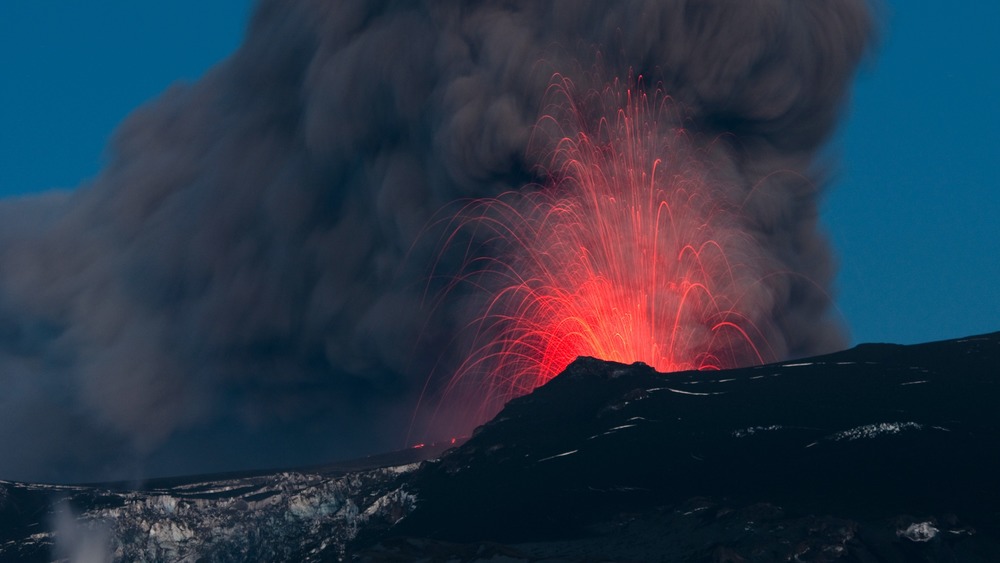The Dramatic True Story Of The Laki Volcanic Eruption
Today, volcanoes are widely considered to be pretty cool. You would be hard-pressed, after all, to go through life without encountering a book or a documentary that's fascinated by the subject, or, for that matter, an enthusiastic young student who's ready to dramatically reenact some of their favorite historical eruptions.
Of course, this subject may seem real in a very different way to the people who still live in the shadow of an active volcano, like the Neapolitans who can look up everyday to see the peak of Pompeii-destroying Mount Vesuvius.
At least most modern folks have the benefit of science and monitoring stations that keep an eye on active volcanoes worldwide, giving them a chance to flee if the worst happens. Yet, that wasn't an option for people throughout most of history. For those living in a time before seismometers and ground deformation detectors, volcanic eruptions were even less predictable than they are today. And, armed with less scientific information about these geological beasts, many wondered if an eruption was akin to divine judgment.
Many must have been thinking of such in 1783, when Iceland's Laki volcano began to erupt. It spewed forth toxic gases and produced lava flows that threatened to overtake entire villages. That thought must have grown even stronger in the intervening months, when the volcano led to a series of famines, a toxic fog, and talk of nothing less than Doomsday itself. Here is the dramatic true story of the Laki volcanic eruption.
The Laki eruption lasted for eight months
Though it didn't have the same immediate explosiveness of other volcanoes like the 1883 eruption of Krakatoa in what's now Indonesia, the 1783 Laki eruption remains one of the most impressive and devastating volcanic events in recorded history.
According to the Bulletin of Volcanology, Laki first began erupting on June 8, 1783. It was part of a larger volcanic system focused on the highly active central volcano of Grímsvötn, which would itself remain highly active until the spring of 1785. Yet, Laki distinguished itself, erupting for a staggering eight months, spewing out deadly lava flows, ash, and poisonous gases.
Surprisingly for some, Laki was not a single volcano. Instead, it was a 27-kilometer (16.7 mile) long volcanic fissure that featured explosions and lava flows along its length. Research indicates that Laki even spewed out fire fountains, which would have been incredible to watch if they weren't also incredibly deadly for nearly anyone in the vicinity. The Bulletin of Volcanology estimates that maximum fire fountain heights reached about 800 to 1400 meters, or over 2,000-feet high. Some of the highest eruption columns, carrying ash and rock fragments called tephra, reached a maximum altitude of 15 kilometers, or over 9 miles into the atmosphere, where Laki would proceed to wreak havoc far beyond its immediate area.
Iceland is a volcano hotspot
Iceland is still full of active volcanoes. Consider the 2010 eruption of Eyjafjallajökull. According to the Smithsonian National Museum of Natural History, the ash cloud created by this fissure eruption was so disruptive that it shut down European air travel for almost a week, with billions in lost money as a result.
Yet, Eyjafjallajökull is just one of many geological features that are continually remaking Iceland's landscape. The Journal of Geodynamics reports that this small island has an unusually diverse array of volcanic activity, from relatively gentle "Hawaiian" style eruptions to dramatically explosive "Plinian" eruptions.
And, at the time of its 1783 eruption, Laki wasn't alone. It was accompanied by Grímsvötn, still one of the most active volcanic systems in Iceland's recorded history. Per the Smithsonian Institution, not only does the volcano throw out lava and ash, but it also sits beneath a thick layer of ice, meaning that sudden floods from melted glaciers are a very real hazard in the area. A 2011 eruption from Grímsvötn produced so much ash that farmers took their livestock in to shelter, while car air filters became heavily clogged after only a few miles of driving. The plume of ash drifted as far south as Britain, where flights over Scotland, Germany, and parts of nearby Scandinavian countries were cancelled. The Laki fissure is part of the larger fissure system extending out from the Grímsvötn volcano itself.
Volcanoes can have a significant effect on the planet's climate
Though many people naturally focus on the immediate changes a volcano can wreak on its surrounding area, many types of volcanic eruptions can also have a significant worldwide presence. People on the other side of the globe may find themselves feeling the effects of a volcanic eruption that they never saw or heard, apart from witnessing its eruption on a television or computer screen.
As the United States Geological Survey reports, volcanoes are now understood to have a significant role in Earth's climate. Depending on the exact type of eruption, a volcano can spew massive amounts of material high into the atmosphere. These materials can include ash, bits of stone, tiny aerosolized droplets, and gases like sulfur dioxide. Aerosols can greatly increase the amount of sunlight that's reflected back into space, thereby lowering temperatures, sometimes to dramatic effect.
Potentially even more dire is the amount of sulfur dioxide that a given volcano can push into the climate. Sulfur dioxide can condense into sulfuric acid, which can disrupt food supplies and produce serious health effects, as some of the unaware victims of Laki soon found out after its 18th century eruption. Still, volcanoes don't produce other greenhouse gases, namely carbon dioxide, on nearly the same level as the amount created by human activity.
Volcanic gases caused widespread famine in Iceland
While the Laki eruption had immediate and definitely very worrisome effects like ash falls and lava flows that threatened to incinerate entire towns, it would turn out that the gases emitted by the volcano would have a far worse legacy than tephra falling out of the sky. Laki, like many volcanoes, spewed forth sulfur dioxide. As the University of Colorado Natural Hazards Center reports, it's estimated that the 1783 eruption produced 120 million tons of the gas, which then reacted with water in the atmosphere to create acidic aerosolized drops. Those drops formed a cloud that then floated south to Europe, where people reported a strange and irritating "dry fog" at least as far south as Italy.
For people in Iceland, however, the sulfuric acid wasn't merely irritating. As the BBC reports, it poisoned much of the plant life on the island. That made grazing difficult for livestock, which then began to fail, and started to push the human population ever closer to starvation. People on the coasts were better supported by fishing, but the chance to ship catches inland to save others was squandered by poor communication and bad government. At the time, Iceland was a territory of Denmark, and communication between nations took weeks. Local officials moved too slowly, also, almost certainly costing lives with their failure to act quickly.
Some people were directly poisoned by Laki
While Laki was busy issuing forth plumes of sulfur dioxide that would eventually form acidic compounds in the atmosphere, it was also producing fluorine. As Wired reports, this gas didn't appear to travel far beyond the island, instead settling into plant matter around Iceland. The livestock that grazed on the plants soon suffered from skeletal fluorosis, a bone disease where fluoride accumulates in the body and weakens bones (via Progress in Food & Nutrition Science). The combined effects of the fluorosis and sulfuric acid in the air, combined with the poor forage, meant that over half of all livestock in Iceland died soon after the eruption.
Today, fluoride poisoning in volcanic areas is still a very real danger. According to Environmental Health Management and Prevention Practices, fluoride can be beneficial in small doses — consider the presence of fluoride in dental treatments and municipal water supplies, which help to keep people's teeth strong and resistant to cavities. But, people living near volcanoes might suffer from overdoses of fluoride, which can have similar skeletal and dental effects to what was suffered by Icelanders and their livestock in the 18th century. That may be more of a problem than you think, since areas around volcanoes also tend to have rich soil that's excellent for agriculture.
One Icelandic priest grew famous because of his "fire mass"
Surely, no one would have blamed Jón Steingrímsson if he had fled. It was barely a month after Laki had erupted, and one of its lava flows was threatening to overtake the town of Kirkjubæjarklaustur, where he was the parish priest. Already, as Medievalist.com reports, he had been witness to a series of personal and community difficulties. Volcanoes were a common hazard in the landscape, while diseases like leprosy and smallpox occasionally broke out amongst Icelanders.
Now, the Laki eruption was disrupting his community's food chain, leading to widespread hunger and starvation. The health effects of the noxious gases emitted by Laki were likewise serious, to the point that Jón's wife, Þórunn Steingrímsson, appears to have died due in part to the effects of malnutrition and the fluorine and sulfur dioxide settling into the environment.
Through it all, Jón kept careful records of the events, noting the suffering experienced by his parishioners in his diary, as Forbes reports. He also wrote that, on July 20, 1783, he delivered what would eventually become known as his eldmessa ("fire mass"), which appeared to stop a lava flow that was poised to take over his town. For the locals who were sheltering in the church, it likely seemed as if their priest had delivered a true miracle. For both this act and his gripping historical record of the Laki eruption and its aftereffects, Jón became legendary.
Laki emitted a toxic fog that drifted over Europe
Perhaps one of Laki's most pernicious and poorly understood effects at the time of its eruption was the cloud of toxic gases that it emitted. As the BBC reports, the volcanic eruption of 1783-1784 produced such a prodigious amount of the stuff, including over 17 megatons (or 17 million tons) of sulfur dioxide, which quickly reacted with the atmosphere to produce an acidic cloud.
That cloud then silently but relentlessly drifted south. Soon enough, people in Britain were reporting some seriously strange weather, with odd fogs that didn't make sense for the summer heat (which was already unusually intense, though that had nothing to do with Laki). Some even began to choke on seemingly nothing. What they didn't understand was that the sulfur dioxide was combining with the water in their lungs, damaging their breathing passages. Modern researchers estimate that as many as 20,000 people in Britain alone may have died because they came into contact with Laki's noxious fumes. People in Scandinavia, Germany, and France suffered similar effects.
Eventually, the fog lifted as summer faded into fall, but that would bring only temporary relief. The winter that followed would be as cold as the preceding summer was hot, almost certainly because sulfur dioxide was still in the atmosphere, deflecting and absorbing the sun's heat.
Laki had worldwide climate consequences
Today, it's all but certain that Laki had an undeniable impact on the environment worldwide. Yet, 18th-century people across the globe would have been pretty poorly situated to understand why, exactly, they were suffering through poisonous hazes, intense winters, and a spate of deadly famines.
Those famines, according to Science Daily, definitely reached as far as Egypt, if not even farther. The climate-disrupting cloud messed with the rain patterns that fed the Nile. Without the annual inundation that washed rich soil up onto the banks of the Nile, farmers and the people who depended on their agricultural output were in a dire situation indeed. It got so bad that one-sixth of Egypt's population at the time died as a direct result of the crop failure and resulting famine.
One French aristocrat, Constantin de Volney, wrote that "Soon after the end of November, the famine carried off, at Cairo, nearly as many as the plague; the streets, which before were full of beggars, now afforded not a single one" (via PEN America). Other nations experienced unexpected weather patterns and famines as far afield as India, Japan, and North America, though an active El Niño weather pattern also came into play, as well as the fact that Japan was dealing with its own volcanic eruption, the May-July 1783 outburst of Mount Asama.
The Laki volcano may have kickstarted the French Revolution
By the time the 1780s rolled around, France was already having a pretty hard go of things. As PEN America reports, a complex web of social inequality and a battery of crop failures and bad weather had set the nation up for some serious civil unrest. That alone should have been enough to account for the 1789 French Revolution that ultimately upended French society and forcefully removed several aristocrats' heads from their bodies. Yet, modern scientists and historians know wonder if none other than the Laki volcano had a hand in the mess, too.
According to The Guardian, the winter immediately following Laki's eruption was a particularly bad one that was followed by floods in many places that further ruined crops and devastated local populations. Food became scarce, and many people subsequently became desperate and more focused on the fact that the king and other high-class people had all of the fancy vittles that they cared to eat. Given that high-stakes food insecurity was a major factor leading up to the revolution, it's very possible that Laki and its cloud of plant-destroying sulfur dioxide had more to do with the eventual revolution than someone like notorious revolution leader Robespierre or his followers could have imagined.
Scientists grappled with the cause of the odd weather
Though some people were at a loss to explain the calamitous events of Laki's eruption and the terrible years that followed, other, more scientific minds began to realize that there might be a deeper connection there, after all.
Scientists and other highly educated people of the era realized that there was a link between the weird "dry fog," as many called it and the climate. Per PEN America, many noted that summer fogs seemed to precede extra difficult winters. Some, like French scientist Morgue de Montredon, had presented a paper about the dry fog as early as August 1783, mere months after Laki started causing trouble. His work studied the weather conditions around Montpellier, France, and concluded that the haze they were all suffering through was packed full of sulfur and must have come from a volcano somewhere.
Since Iceland was already known as volcano central by the 18th century, Montredon and many others guessed that the culprit was somewhere there, though they mistakenly blamed a short-lived but dramatic volcanic island just off the Icelandic coast, called Nyey.
Others were also busy noting the effects of the haze, like Sir John Cullum's description of the odd "frost" that descended upon Suffolk, England. As quoted in GeoBritannica, he wrote that the frost had landed in his garden "exactly as if a fire had been lighted near them, that had shrivelled and discoloured their leaves."
Ben Franklin tried to understand the problems caused by volcanoes
With so many scientists and other scholars buzzing about the events of 1783 and 1784, it's no wonder that one of the most famous minds of the age would eventually get involved. Sitting in France as an American diplomat, none other than Ben Franklin turned his intellect to the problem.
As PEN America reports, Franklin first published his thoughts on the matter in a 1784 letter he wrote to a British colleague, which was later made public. As far as anyone can tell, this is the first English-language report that linked climate conditions to volcanic eruptions. "The cause of this universal fog is not yet ascertained," he wrote, wondering if "it was the vast quantity of smoke, long continuing to issue during the summer from Hecla [sic] in Iceland, and that other volcano which arose out of the sea near that island."
While Franklin got pretty close to the truth, he wasn't totally on base. He also wondered if meteors or other space phenomena might have something to do with the haze and the subsequent cold winter. Neither did he get the exact volcano right, as the Hekla volcano didn't have anything to do with the matter and was probably just the most well-known to Franklin and friends.
Some worried that Laki was a divine punishment
At a time when the Enlightenment was just beginning to take off, this widespread disaster led some to backtrack on scientific progress, or at least fall back into some old-fashioned fire and brimstone, end-of-days style of preaching. Jón Steingrímsson, the Icelandic priest of "fire mass" fame, wrote that anyone reading his account of the Laki eruption and its after effects should use it as a "reflection and reminder of the end of the world and the Doomsday fires" (via Harvard Map Collection).
Parson Gilbert White, of Selborne, England, also couldn't help but connect the haze over his country to some pretty dour religious ideas. As he wrote in The Natural History of Selborne, the year 1783 was "amazing and portentous" in part because of the "peculiar haze" that troubled the village and made the sun look apocalyptically red. "The country people began to look with a superstitious awe at the red lowering aspect of the sun." Even the educated White indulged in similar thinking, reflecting on similar ominous imagery he'd read about in John Milton's Paradise Lost.
Some even argue that Iceland lost many of its traditional dances in the volcanic aftermath. The BBC reports that a traumatized population just didn't have the heart to keep dancing, leading some of its unique folkways to simply fade into the past, all because of Laki.
